Research Report: Observation Methods and Data Collection Techniques
VerifiedAdded on 2022/12/26
|17
|6315
|3
Report
AI Summary
This report delves into the intricacies of observation as a primary research method within the realm of international business. It commences by defining observation and outlining its advantages and disadvantages, providing a foundational understanding of its application in data collection. The report then dissects four key dimensions that differentiate various observational approaches, offering a nuanced perspective on methodologies. Furthermore, it addresses the critical issue of observer bias, proposing practical strategies for its minimization. The ethical dimensions of concealed observation are critically evaluated, highlighting the importance of responsible research practices. The second part of the report shifts focus to questionnaire design, examining the mechanisms for administering online questionnaires, along with their respective pros and cons. Principles of wording and their significance in questionnaire construction are discussed, emphasizing the importance of clarity and precision. The report also explores how multiple methods of data collection and diverse data sources contribute to the validity and reliability of research measures. The report concludes with a critical evaluation of a given statement, drawing together the various concepts discussed throughout.
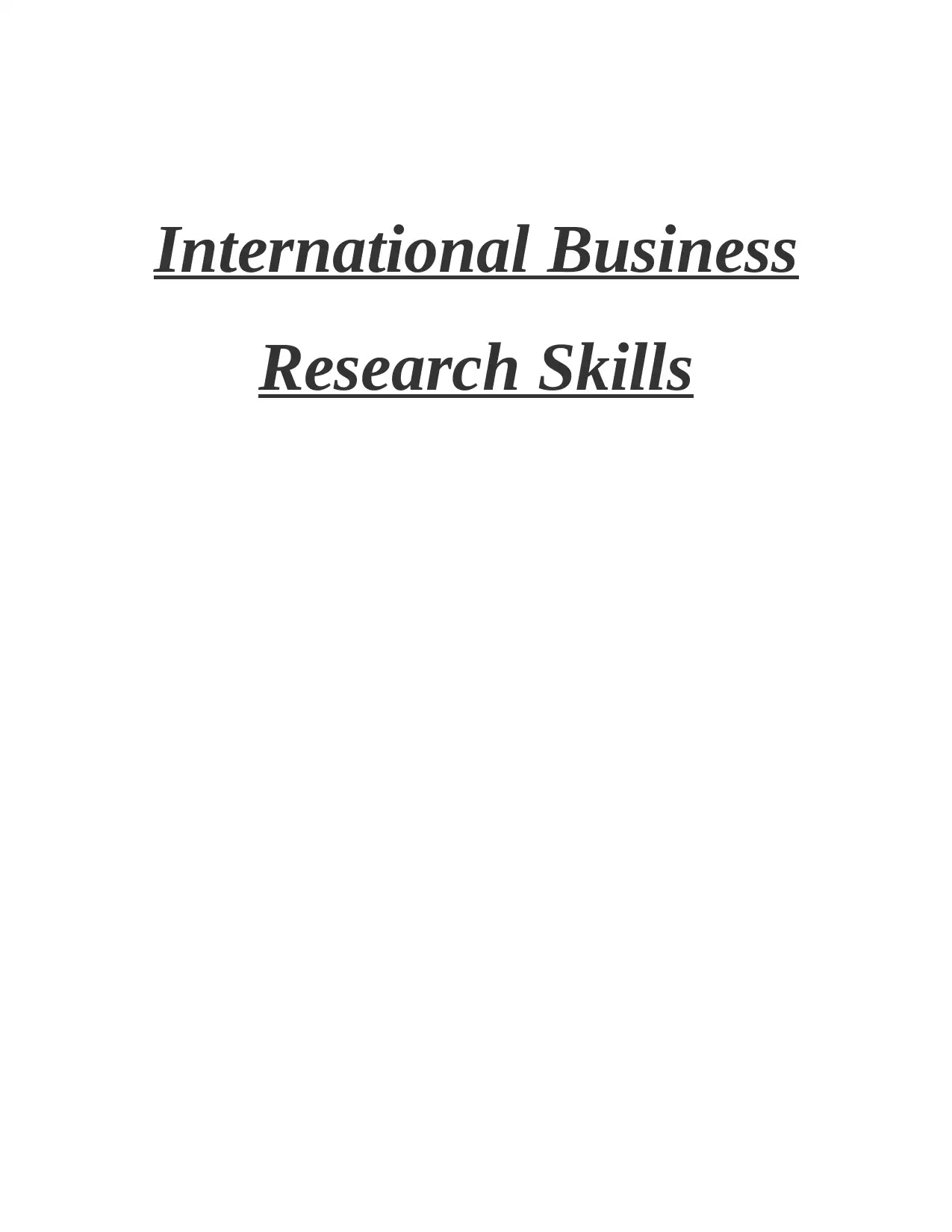
International Business
Research Skills
Research Skills
Paraphrase This Document
Need a fresh take? Get an instant paraphrase of this document with our AI Paraphraser

Table of Contents
INTRODUCTION...........................................................................................................................2
TASK 1............................................................................................................................................3
Purpose of observation, along with advantages and disadvantages.......................................3
2. Four dimensions that distinguish various approaches to observation................................5
3. Discuss at least two ways of minimizing observer bias.....................................................9
4 Critical evaluation of ethics of using concealed observation method...............................10
TASK 2..........................................................................................................................................11
1. Discussion of mechanism that administer online questionnaire with its advantage &
disadvantages........................................................................................................................11
2. Principles of wording, stating and how these are significant in questionnaire design.....12
3. How multiple methods of data collection & from multiple sources associated to validity and
reliability of measures.........................................................................................................13
4. Critical evaluation of the given statement........................................................................14
REFERENCES..............................................................................................................................16
INTRODUCTION...........................................................................................................................2
TASK 1............................................................................................................................................3
Purpose of observation, along with advantages and disadvantages.......................................3
2. Four dimensions that distinguish various approaches to observation................................5
3. Discuss at least two ways of minimizing observer bias.....................................................9
4 Critical evaluation of ethics of using concealed observation method...............................10
TASK 2..........................................................................................................................................11
1. Discussion of mechanism that administer online questionnaire with its advantage &
disadvantages........................................................................................................................11
2. Principles of wording, stating and how these are significant in questionnaire design.....12
3. How multiple methods of data collection & from multiple sources associated to validity and
reliability of measures.........................................................................................................13
4. Critical evaluation of the given statement........................................................................14
REFERENCES..............................................................................................................................16
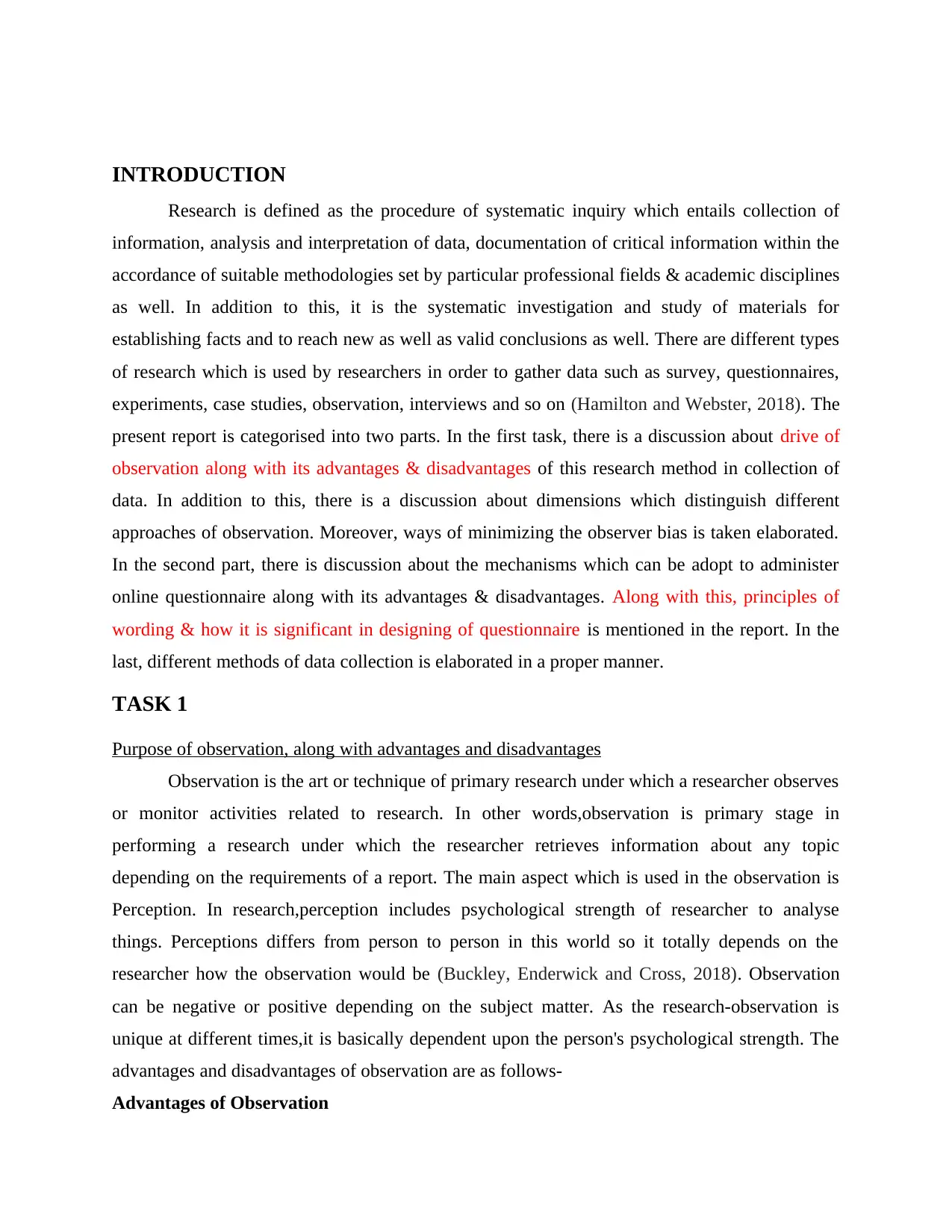
INTRODUCTION
Research is defined as the procedure of systematic inquiry which entails collection of
information, analysis and interpretation of data, documentation of critical information within the
accordance of suitable methodologies set by particular professional fields & academic disciplines
as well. In addition to this, it is the systematic investigation and study of materials for
establishing facts and to reach new as well as valid conclusions as well. There are different types
of research which is used by researchers in order to gather data such as survey, questionnaires,
experiments, case studies, observation, interviews and so on (Hamilton and Webster, 2018). The
present report is categorised into two parts. In the first task, there is a discussion about drive of
observation along with its advantages & disadvantages of this research method in collection of
data. In addition to this, there is a discussion about dimensions which distinguish different
approaches of observation. Moreover, ways of minimizing the observer bias is taken elaborated.
In the second part, there is discussion about the mechanisms which can be adopt to administer
online questionnaire along with its advantages & disadvantages. Along with this, principles of
wording & how it is significant in designing of questionnaire is mentioned in the report. In the
last, different methods of data collection is elaborated in a proper manner.
TASK 1
Purpose of observation, along with advantages and disadvantages
Observation is the art or technique of primary research under which a researcher observes
or monitor activities related to research. In other words,observation is primary stage in
performing a research under which the researcher retrieves information about any topic
depending on the requirements of a report. The main aspect which is used in the observation is
Perception. In research,perception includes psychological strength of researcher to analyse
things. Perceptions differs from person to person in this world so it totally depends on the
researcher how the observation would be (Buckley, Enderwick and Cross, 2018). Observation
can be negative or positive depending on the subject matter. As the research-observation is
unique at different times,it is basically dependent upon the person's psychological strength. The
advantages and disadvantages of observation are as follows-
Advantages of Observation
Research is defined as the procedure of systematic inquiry which entails collection of
information, analysis and interpretation of data, documentation of critical information within the
accordance of suitable methodologies set by particular professional fields & academic disciplines
as well. In addition to this, it is the systematic investigation and study of materials for
establishing facts and to reach new as well as valid conclusions as well. There are different types
of research which is used by researchers in order to gather data such as survey, questionnaires,
experiments, case studies, observation, interviews and so on (Hamilton and Webster, 2018). The
present report is categorised into two parts. In the first task, there is a discussion about drive of
observation along with its advantages & disadvantages of this research method in collection of
data. In addition to this, there is a discussion about dimensions which distinguish different
approaches of observation. Moreover, ways of minimizing the observer bias is taken elaborated.
In the second part, there is discussion about the mechanisms which can be adopt to administer
online questionnaire along with its advantages & disadvantages. Along with this, principles of
wording & how it is significant in designing of questionnaire is mentioned in the report. In the
last, different methods of data collection is elaborated in a proper manner.
TASK 1
Purpose of observation, along with advantages and disadvantages
Observation is the art or technique of primary research under which a researcher observes
or monitor activities related to research. In other words,observation is primary stage in
performing a research under which the researcher retrieves information about any topic
depending on the requirements of a report. The main aspect which is used in the observation is
Perception. In research,perception includes psychological strength of researcher to analyse
things. Perceptions differs from person to person in this world so it totally depends on the
researcher how the observation would be (Buckley, Enderwick and Cross, 2018). Observation
can be negative or positive depending on the subject matter. As the research-observation is
unique at different times,it is basically dependent upon the person's psychological strength. The
advantages and disadvantages of observation are as follows-
Advantages of Observation
⊘ This is a preview!⊘
Do you want full access?
Subscribe today to unlock all pages.

Trusted by 1+ million students worldwide
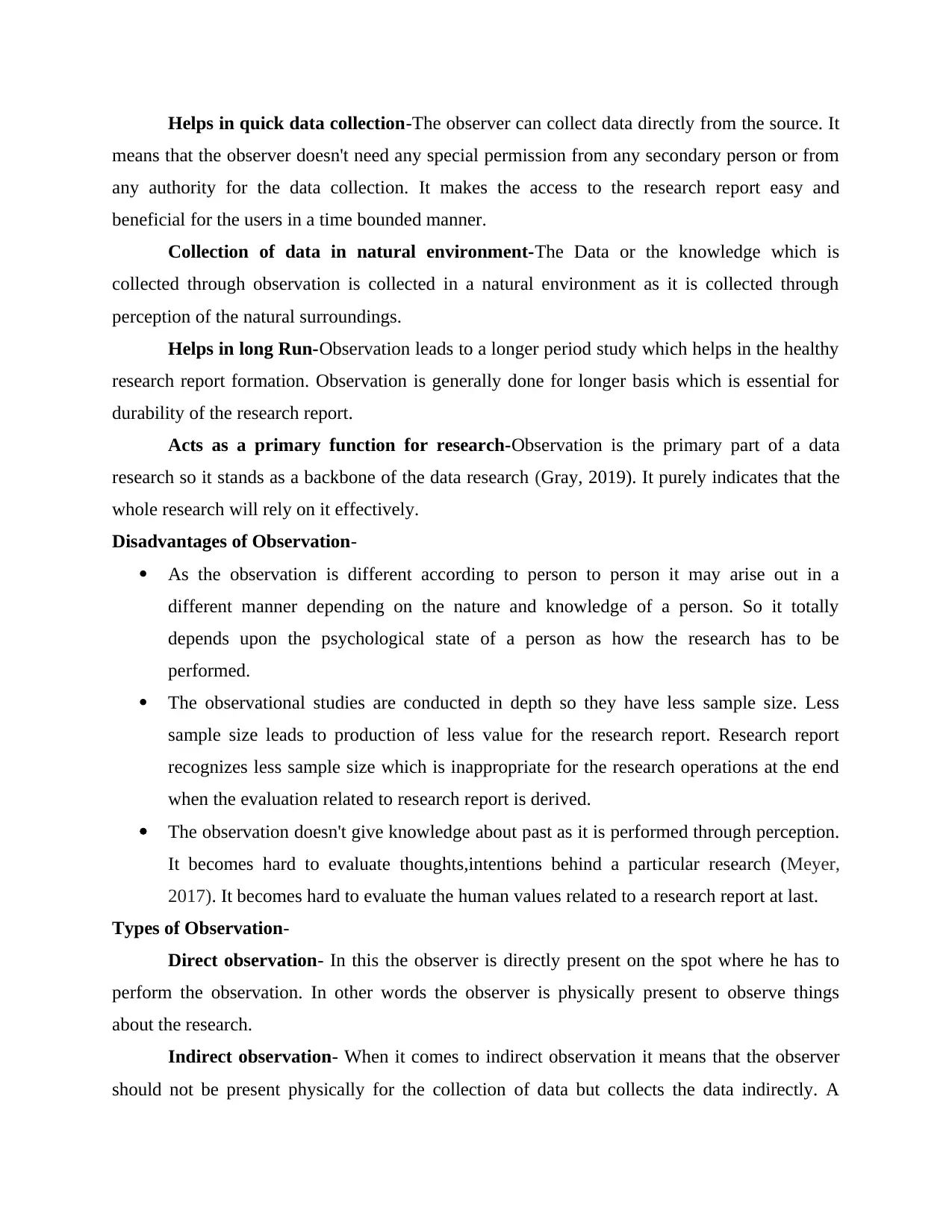
Helps in quick data collection-The observer can collect data directly from the source. It
means that the observer doesn't need any special permission from any secondary person or from
any authority for the data collection. It makes the access to the research report easy and
beneficial for the users in a time bounded manner.
Collection of data in natural environment-The Data or the knowledge which is
collected through observation is collected in a natural environment as it is collected through
perception of the natural surroundings.
Helps in long Run-Observation leads to a longer period study which helps in the healthy
research report formation. Observation is generally done for longer basis which is essential for
durability of the research report.
Acts as a primary function for research-Observation is the primary part of a data
research so it stands as a backbone of the data research (Gray, 2019). It purely indicates that the
whole research will rely on it effectively.
Disadvantages of Observation-
As the observation is different according to person to person it may arise out in a
different manner depending on the nature and knowledge of a person. So it totally
depends upon the psychological state of a person as how the research has to be
performed.
The observational studies are conducted in depth so they have less sample size. Less
sample size leads to production of less value for the research report. Research report
recognizes less sample size which is inappropriate for the research operations at the end
when the evaluation related to research report is derived.
The observation doesn't give knowledge about past as it is performed through perception.
It becomes hard to evaluate thoughts,intentions behind a particular research (Meyer,
2017). It becomes hard to evaluate the human values related to a research report at last.
Types of Observation-
Direct observation- In this the observer is directly present on the spot where he has to
perform the observation. In other words the observer is physically present to observe things
about the research.
Indirect observation- When it comes to indirect observation it means that the observer
should not be present physically for the collection of data but collects the data indirectly. A
means that the observer doesn't need any special permission from any secondary person or from
any authority for the data collection. It makes the access to the research report easy and
beneficial for the users in a time bounded manner.
Collection of data in natural environment-The Data or the knowledge which is
collected through observation is collected in a natural environment as it is collected through
perception of the natural surroundings.
Helps in long Run-Observation leads to a longer period study which helps in the healthy
research report formation. Observation is generally done for longer basis which is essential for
durability of the research report.
Acts as a primary function for research-Observation is the primary part of a data
research so it stands as a backbone of the data research (Gray, 2019). It purely indicates that the
whole research will rely on it effectively.
Disadvantages of Observation-
As the observation is different according to person to person it may arise out in a
different manner depending on the nature and knowledge of a person. So it totally
depends upon the psychological state of a person as how the research has to be
performed.
The observational studies are conducted in depth so they have less sample size. Less
sample size leads to production of less value for the research report. Research report
recognizes less sample size which is inappropriate for the research operations at the end
when the evaluation related to research report is derived.
The observation doesn't give knowledge about past as it is performed through perception.
It becomes hard to evaluate thoughts,intentions behind a particular research (Meyer,
2017). It becomes hard to evaluate the human values related to a research report at last.
Types of Observation-
Direct observation- In this the observer is directly present on the spot where he has to
perform the observation. In other words the observer is physically present to observe things
about the research.
Indirect observation- When it comes to indirect observation it means that the observer
should not be present physically for the collection of data but collects the data indirectly. A
Paraphrase This Document
Need a fresh take? Get an instant paraphrase of this document with our AI Paraphraser
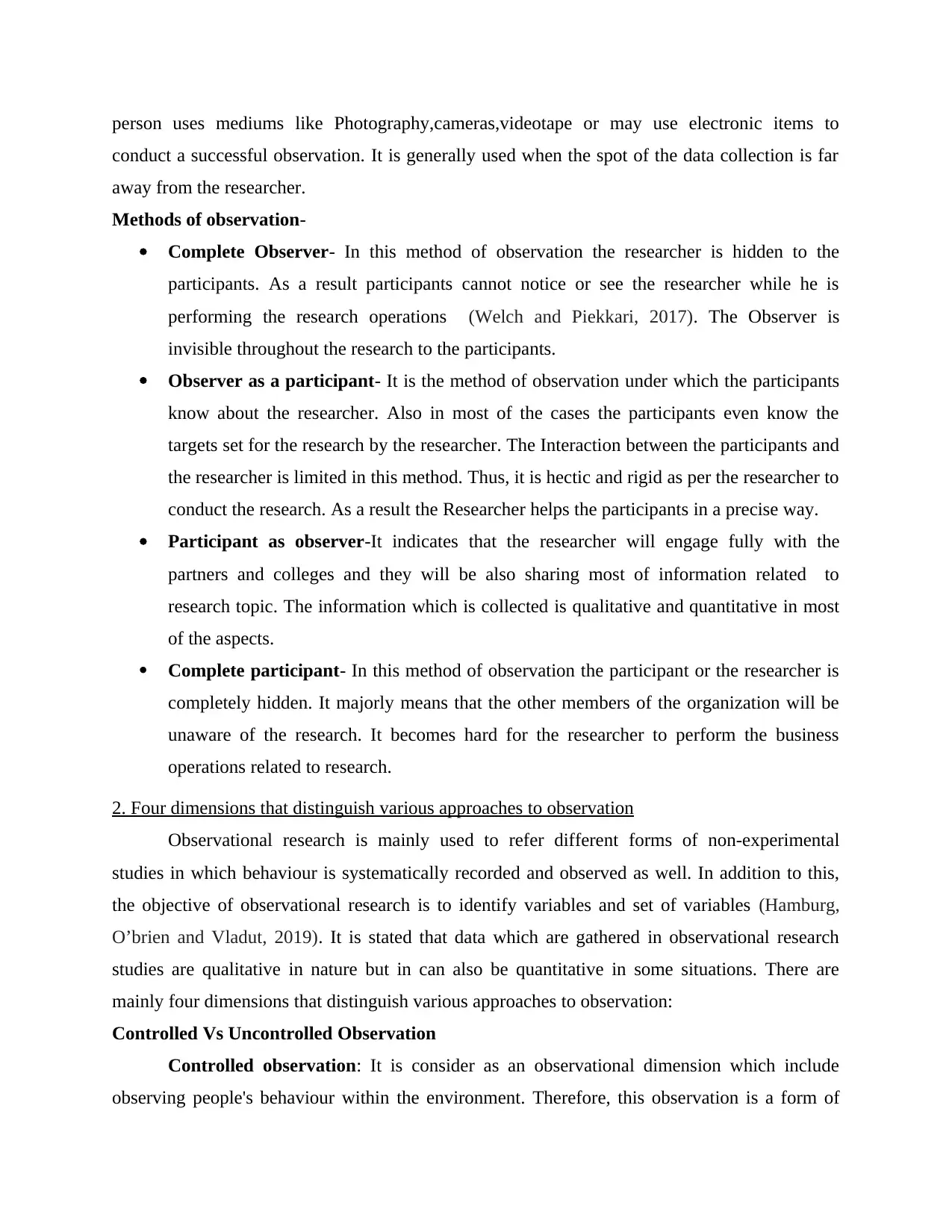
person uses mediums like Photography,cameras,videotape or may use electronic items to
conduct a successful observation. It is generally used when the spot of the data collection is far
away from the researcher.
Methods of observation-
Complete Observer- In this method of observation the researcher is hidden to the
participants. As a result participants cannot notice or see the researcher while he is
performing the research operations (Welch and Piekkari, 2017). The Observer is
invisible throughout the research to the participants.
Observer as a participant- It is the method of observation under which the participants
know about the researcher. Also in most of the cases the participants even know the
targets set for the research by the researcher. The Interaction between the participants and
the researcher is limited in this method. Thus, it is hectic and rigid as per the researcher to
conduct the research. As a result the Researcher helps the participants in a precise way.
Participant as observer-It indicates that the researcher will engage fully with the
partners and colleges and they will be also sharing most of information related to
research topic. The information which is collected is qualitative and quantitative in most
of the aspects.
Complete participant- In this method of observation the participant or the researcher is
completely hidden. It majorly means that the other members of the organization will be
unaware of the research. It becomes hard for the researcher to perform the business
operations related to research.
2. Four dimensions that distinguish various approaches to observation
Observational research is mainly used to refer different forms of non-experimental
studies in which behaviour is systematically recorded and observed as well. In addition to this,
the objective of observational research is to identify variables and set of variables (Hamburg,
O’brien and Vladut, 2019). It is stated that data which are gathered in observational research
studies are qualitative in nature but in can also be quantitative in some situations. There are
mainly four dimensions that distinguish various approaches to observation:
Controlled Vs Uncontrolled Observation
Controlled observation: It is consider as an observational dimension which include
observing people's behaviour within the environment. Therefore, this observation is a form of
conduct a successful observation. It is generally used when the spot of the data collection is far
away from the researcher.
Methods of observation-
Complete Observer- In this method of observation the researcher is hidden to the
participants. As a result participants cannot notice or see the researcher while he is
performing the research operations (Welch and Piekkari, 2017). The Observer is
invisible throughout the research to the participants.
Observer as a participant- It is the method of observation under which the participants
know about the researcher. Also in most of the cases the participants even know the
targets set for the research by the researcher. The Interaction between the participants and
the researcher is limited in this method. Thus, it is hectic and rigid as per the researcher to
conduct the research. As a result the Researcher helps the participants in a precise way.
Participant as observer-It indicates that the researcher will engage fully with the
partners and colleges and they will be also sharing most of information related to
research topic. The information which is collected is qualitative and quantitative in most
of the aspects.
Complete participant- In this method of observation the participant or the researcher is
completely hidden. It majorly means that the other members of the organization will be
unaware of the research. It becomes hard for the researcher to perform the business
operations related to research.
2. Four dimensions that distinguish various approaches to observation
Observational research is mainly used to refer different forms of non-experimental
studies in which behaviour is systematically recorded and observed as well. In addition to this,
the objective of observational research is to identify variables and set of variables (Hamburg,
O’brien and Vladut, 2019). It is stated that data which are gathered in observational research
studies are qualitative in nature but in can also be quantitative in some situations. There are
mainly four dimensions that distinguish various approaches to observation:
Controlled Vs Uncontrolled Observation
Controlled observation: It is consider as an observational dimension which include
observing people's behaviour within the environment. Therefore, this observation is a form of
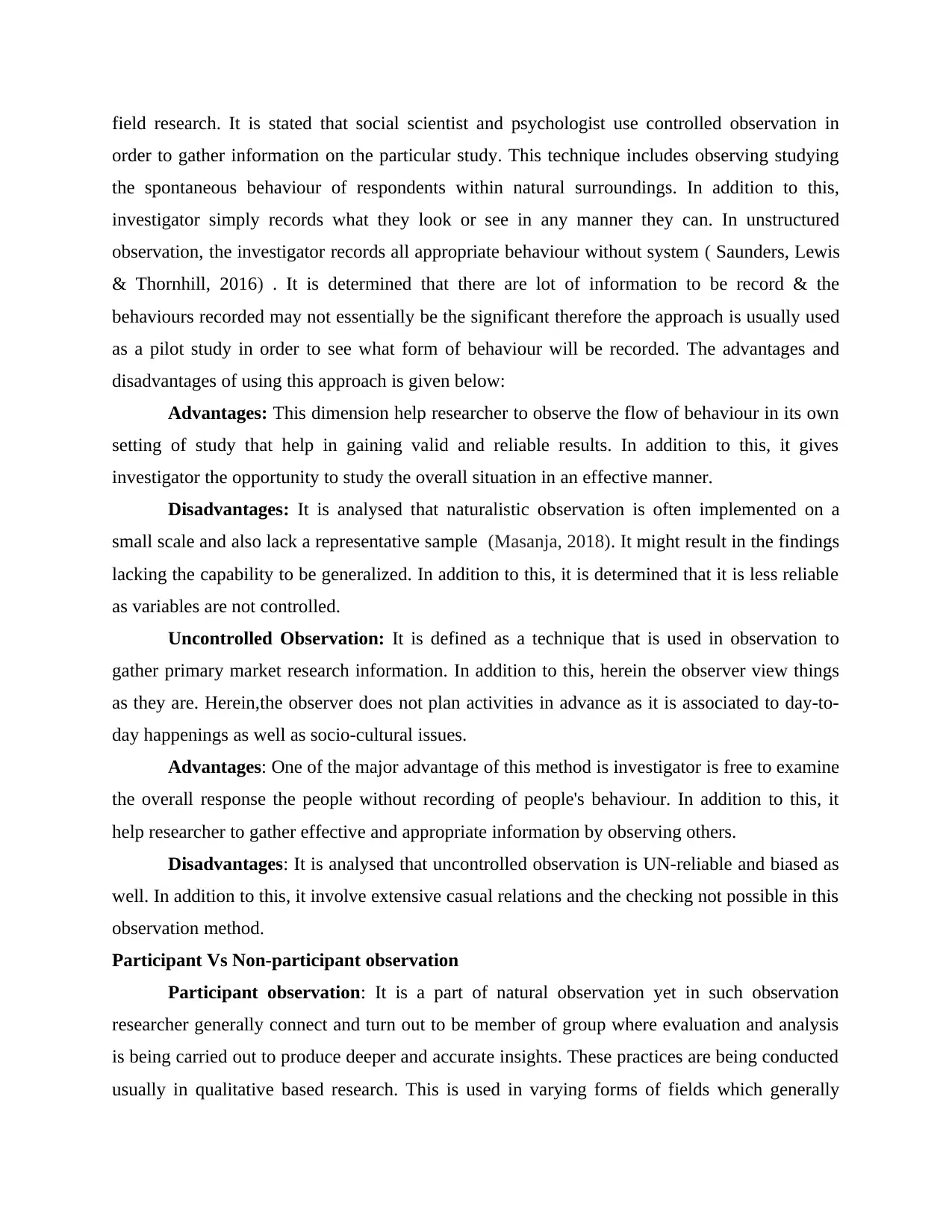
field research. It is stated that social scientist and psychologist use controlled observation in
order to gather information on the particular study. This technique includes observing studying
the spontaneous behaviour of respondents within natural surroundings. In addition to this,
investigator simply records what they look or see in any manner they can. In unstructured
observation, the investigator records all appropriate behaviour without system ( Saunders, Lewis
& Thornhill, 2016) . It is determined that there are lot of information to be record & the
behaviours recorded may not essentially be the significant therefore the approach is usually used
as a pilot study in order to see what form of behaviour will be recorded. The advantages and
disadvantages of using this approach is given below:
Advantages: This dimension help researcher to observe the flow of behaviour in its own
setting of study that help in gaining valid and reliable results. In addition to this, it gives
investigator the opportunity to study the overall situation in an effective manner.
Disadvantages: It is analysed that naturalistic observation is often implemented on a
small scale and also lack a representative sample (Masanja, 2018). It might result in the findings
lacking the capability to be generalized. In addition to this, it is determined that it is less reliable
as variables are not controlled.
Uncontrolled Observation: It is defined as a technique that is used in observation to
gather primary market research information. In addition to this, herein the observer view things
as they are. Herein,the observer does not plan activities in advance as it is associated to day-to-
day happenings as well as socio-cultural issues.
Advantages: One of the major advantage of this method is investigator is free to examine
the overall response the people without recording of people's behaviour. In addition to this, it
help researcher to gather effective and appropriate information by observing others.
Disadvantages: It is analysed that uncontrolled observation is UN-reliable and biased as
well. In addition to this, it involve extensive casual relations and the checking not possible in this
observation method.
Participant Vs Non-participant observation
Participant observation: It is a part of natural observation yet in such observation
researcher generally connect and turn out to be member of group where evaluation and analysis
is being carried out to produce deeper and accurate insights. These practices are being conducted
usually in qualitative based research. This is used in varying forms of fields which generally
order to gather information on the particular study. This technique includes observing studying
the spontaneous behaviour of respondents within natural surroundings. In addition to this,
investigator simply records what they look or see in any manner they can. In unstructured
observation, the investigator records all appropriate behaviour without system ( Saunders, Lewis
& Thornhill, 2016) . It is determined that there are lot of information to be record & the
behaviours recorded may not essentially be the significant therefore the approach is usually used
as a pilot study in order to see what form of behaviour will be recorded. The advantages and
disadvantages of using this approach is given below:
Advantages: This dimension help researcher to observe the flow of behaviour in its own
setting of study that help in gaining valid and reliable results. In addition to this, it gives
investigator the opportunity to study the overall situation in an effective manner.
Disadvantages: It is analysed that naturalistic observation is often implemented on a
small scale and also lack a representative sample (Masanja, 2018). It might result in the findings
lacking the capability to be generalized. In addition to this, it is determined that it is less reliable
as variables are not controlled.
Uncontrolled Observation: It is defined as a technique that is used in observation to
gather primary market research information. In addition to this, herein the observer view things
as they are. Herein,the observer does not plan activities in advance as it is associated to day-to-
day happenings as well as socio-cultural issues.
Advantages: One of the major advantage of this method is investigator is free to examine
the overall response the people without recording of people's behaviour. In addition to this, it
help researcher to gather effective and appropriate information by observing others.
Disadvantages: It is analysed that uncontrolled observation is UN-reliable and biased as
well. In addition to this, it involve extensive casual relations and the checking not possible in this
observation method.
Participant Vs Non-participant observation
Participant observation: It is a part of natural observation yet in such observation
researcher generally connect and turn out to be member of group where evaluation and analysis
is being carried out to produce deeper and accurate insights. These practices are being conducted
usually in qualitative based research. This is used in varying forms of fields which generally
⊘ This is a preview!⊘
Do you want full access?
Subscribe today to unlock all pages.

Trusted by 1+ million students worldwide
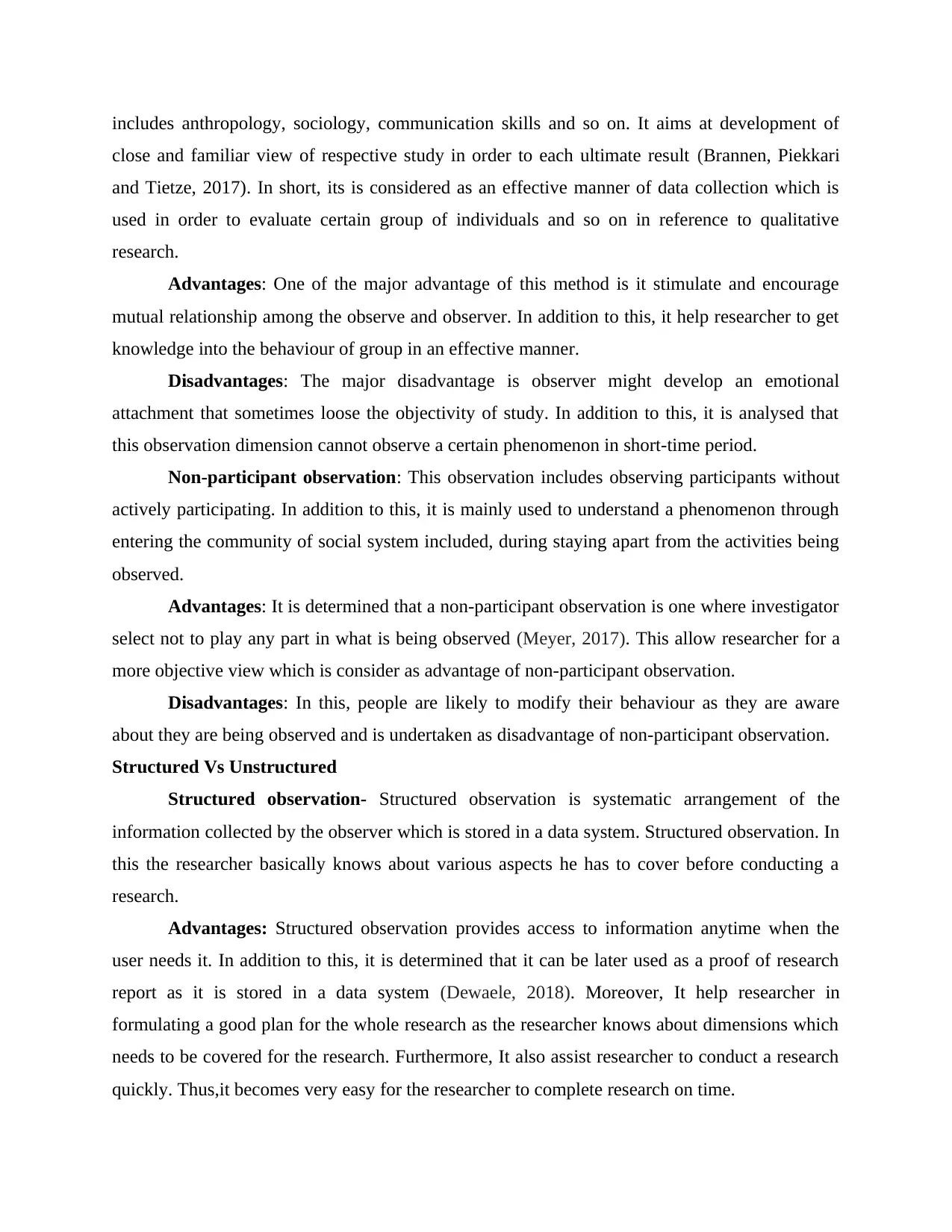
includes anthropology, sociology, communication skills and so on. It aims at development of
close and familiar view of respective study in order to each ultimate result (Brannen, Piekkari
and Tietze, 2017). In short, its is considered as an effective manner of data collection which is
used in order to evaluate certain group of individuals and so on in reference to qualitative
research.
Advantages: One of the major advantage of this method is it stimulate and encourage
mutual relationship among the observe and observer. In addition to this, it help researcher to get
knowledge into the behaviour of group in an effective manner.
Disadvantages: The major disadvantage is observer might develop an emotional
attachment that sometimes loose the objectivity of study. In addition to this, it is analysed that
this observation dimension cannot observe a certain phenomenon in short-time period.
Non-participant observation: This observation includes observing participants without
actively participating. In addition to this, it is mainly used to understand a phenomenon through
entering the community of social system included, during staying apart from the activities being
observed.
Advantages: It is determined that a non-participant observation is one where investigator
select not to play any part in what is being observed (Meyer, 2017). This allow researcher for a
more objective view which is consider as advantage of non-participant observation.
Disadvantages: In this, people are likely to modify their behaviour as they are aware
about they are being observed and is undertaken as disadvantage of non-participant observation.
Structured Vs Unstructured
Structured observation- Structured observation is systematic arrangement of the
information collected by the observer which is stored in a data system. Structured observation. In
this the researcher basically knows about various aspects he has to cover before conducting a
research.
Advantages: Structured observation provides access to information anytime when the
user needs it. In addition to this, it is determined that it can be later used as a proof of research
report as it is stored in a data system (Dewaele, 2018). Moreover, It help researcher in
formulating a good plan for the whole research as the researcher knows about dimensions which
needs to be covered for the research. Furthermore, It also assist researcher to conduct a research
quickly. Thus,it becomes very easy for the researcher to complete research on time.
close and familiar view of respective study in order to each ultimate result (Brannen, Piekkari
and Tietze, 2017). In short, its is considered as an effective manner of data collection which is
used in order to evaluate certain group of individuals and so on in reference to qualitative
research.
Advantages: One of the major advantage of this method is it stimulate and encourage
mutual relationship among the observe and observer. In addition to this, it help researcher to get
knowledge into the behaviour of group in an effective manner.
Disadvantages: The major disadvantage is observer might develop an emotional
attachment that sometimes loose the objectivity of study. In addition to this, it is analysed that
this observation dimension cannot observe a certain phenomenon in short-time period.
Non-participant observation: This observation includes observing participants without
actively participating. In addition to this, it is mainly used to understand a phenomenon through
entering the community of social system included, during staying apart from the activities being
observed.
Advantages: It is determined that a non-participant observation is one where investigator
select not to play any part in what is being observed (Meyer, 2017). This allow researcher for a
more objective view which is consider as advantage of non-participant observation.
Disadvantages: In this, people are likely to modify their behaviour as they are aware
about they are being observed and is undertaken as disadvantage of non-participant observation.
Structured Vs Unstructured
Structured observation- Structured observation is systematic arrangement of the
information collected by the observer which is stored in a data system. Structured observation. In
this the researcher basically knows about various aspects he has to cover before conducting a
research.
Advantages: Structured observation provides access to information anytime when the
user needs it. In addition to this, it is determined that it can be later used as a proof of research
report as it is stored in a data system (Dewaele, 2018). Moreover, It help researcher in
formulating a good plan for the whole research as the researcher knows about dimensions which
needs to be covered for the research. Furthermore, It also assist researcher to conduct a research
quickly. Thus,it becomes very easy for the researcher to complete research on time.
Paraphrase This Document
Need a fresh take? Get an instant paraphrase of this document with our AI Paraphraser
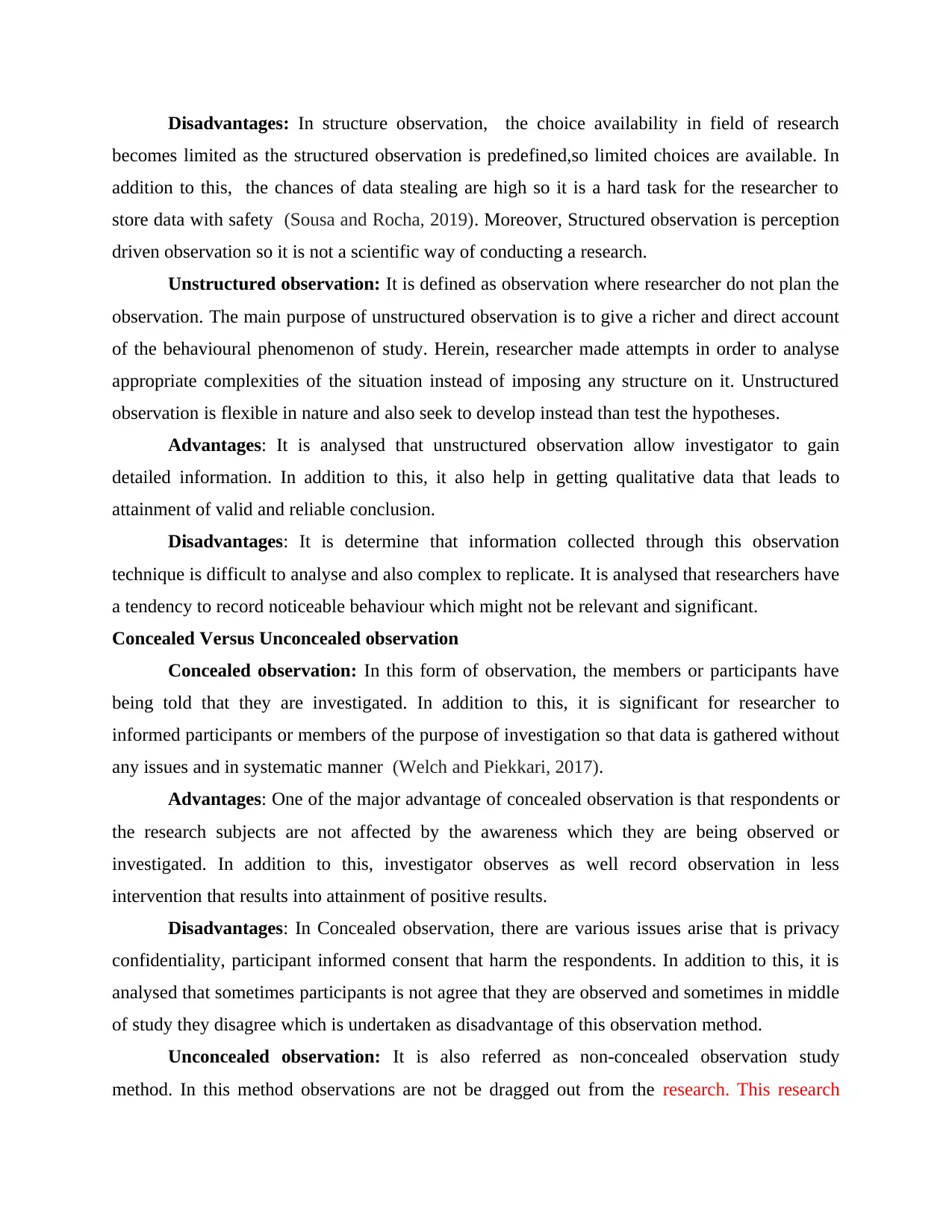
Disadvantages: In structure observation, the choice availability in field of research
becomes limited as the structured observation is predefined,so limited choices are available. In
addition to this, the chances of data stealing are high so it is a hard task for the researcher to
store data with safety (Sousa and Rocha, 2019). Moreover, Structured observation is perception
driven observation so it is not a scientific way of conducting a research.
Unstructured observation: It is defined as observation where researcher do not plan the
observation. The main purpose of unstructured observation is to give a richer and direct account
of the behavioural phenomenon of study. Herein, researcher made attempts in order to analyse
appropriate complexities of the situation instead of imposing any structure on it. Unstructured
observation is flexible in nature and also seek to develop instead than test the hypotheses.
Advantages: It is analysed that unstructured observation allow investigator to gain
detailed information. In addition to this, it also help in getting qualitative data that leads to
attainment of valid and reliable conclusion.
Disadvantages: It is determine that information collected through this observation
technique is difficult to analyse and also complex to replicate. It is analysed that researchers have
a tendency to record noticeable behaviour which might not be relevant and significant.
Concealed Versus Unconcealed observation
Concealed observation: In this form of observation, the members or participants have
being told that they are investigated. In addition to this, it is significant for researcher to
informed participants or members of the purpose of investigation so that data is gathered without
any issues and in systematic manner (Welch and Piekkari, 2017).
Advantages: One of the major advantage of concealed observation is that respondents or
the research subjects are not affected by the awareness which they are being observed or
investigated. In addition to this, investigator observes as well record observation in less
intervention that results into attainment of positive results.
Disadvantages: In Concealed observation, there are various issues arise that is privacy
confidentiality, participant informed consent that harm the respondents. In addition to this, it is
analysed that sometimes participants is not agree that they are observed and sometimes in middle
of study they disagree which is undertaken as disadvantage of this observation method.
Unconcealed observation: It is also referred as non-concealed observation study
method. In this method observations are not be dragged out from the research. This research
becomes limited as the structured observation is predefined,so limited choices are available. In
addition to this, the chances of data stealing are high so it is a hard task for the researcher to
store data with safety (Sousa and Rocha, 2019). Moreover, Structured observation is perception
driven observation so it is not a scientific way of conducting a research.
Unstructured observation: It is defined as observation where researcher do not plan the
observation. The main purpose of unstructured observation is to give a richer and direct account
of the behavioural phenomenon of study. Herein, researcher made attempts in order to analyse
appropriate complexities of the situation instead of imposing any structure on it. Unstructured
observation is flexible in nature and also seek to develop instead than test the hypotheses.
Advantages: It is analysed that unstructured observation allow investigator to gain
detailed information. In addition to this, it also help in getting qualitative data that leads to
attainment of valid and reliable conclusion.
Disadvantages: It is determine that information collected through this observation
technique is difficult to analyse and also complex to replicate. It is analysed that researchers have
a tendency to record noticeable behaviour which might not be relevant and significant.
Concealed Versus Unconcealed observation
Concealed observation: In this form of observation, the members or participants have
being told that they are investigated. In addition to this, it is significant for researcher to
informed participants or members of the purpose of investigation so that data is gathered without
any issues and in systematic manner (Welch and Piekkari, 2017).
Advantages: One of the major advantage of concealed observation is that respondents or
the research subjects are not affected by the awareness which they are being observed or
investigated. In addition to this, investigator observes as well record observation in less
intervention that results into attainment of positive results.
Disadvantages: In Concealed observation, there are various issues arise that is privacy
confidentiality, participant informed consent that harm the respondents. In addition to this, it is
analysed that sometimes participants is not agree that they are observed and sometimes in middle
of study they disagree which is undertaken as disadvantage of this observation method.
Unconcealed observation: It is also referred as non-concealed observation study
method. In this method observations are not be dragged out from the research. This research
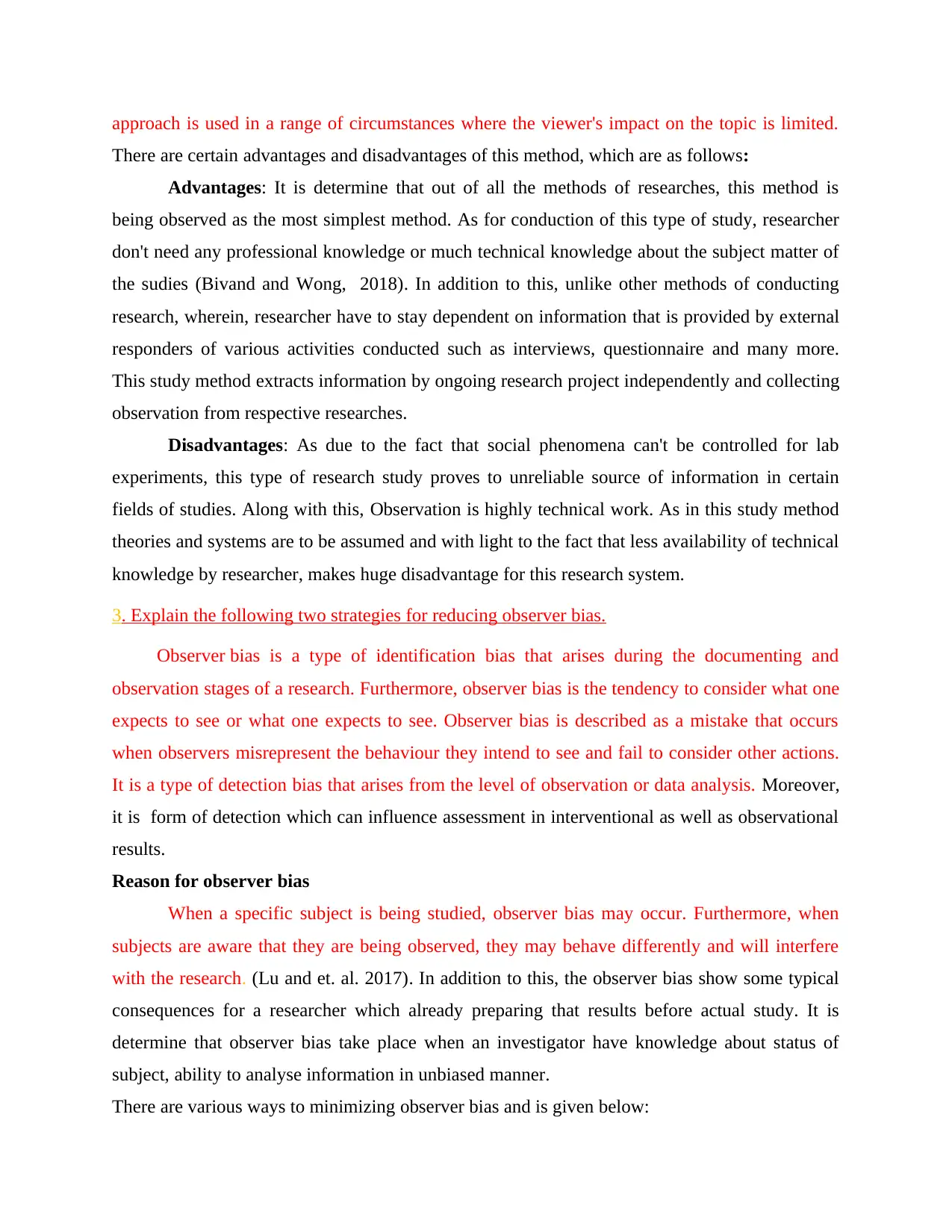
approach is used in a range of circumstances where the viewer's impact on the topic is limited.
There are certain advantages and disadvantages of this method, which are as follows:
Advantages: It is determine that out of all the methods of researches, this method is
being observed as the most simplest method. As for conduction of this type of study, researcher
don't need any professional knowledge or much technical knowledge about the subject matter of
the sudies (Bivand and Wong, 2018). In addition to this, unlike other methods of conducting
research, wherein, researcher have to stay dependent on information that is provided by external
responders of various activities conducted such as interviews, questionnaire and many more.
This study method extracts information by ongoing research project independently and collecting
observation from respective researches.
Disadvantages: As due to the fact that social phenomena can't be controlled for lab
experiments, this type of research study proves to unreliable source of information in certain
fields of studies. Along with this, Observation is highly technical work. As in this study method
theories and systems are to be assumed and with light to the fact that less availability of technical
knowledge by researcher, makes huge disadvantage for this research system.
3. Explain the following two strategies for reducing observer bias.
Observer bias is a type of identification bias that arises during the documenting and
observation stages of a research. Furthermore, observer bias is the tendency to consider what one
expects to see or what one expects to see. Observer bias is described as a mistake that occurs
when observers misrepresent the behaviour they intend to see and fail to consider other actions.
It is a type of detection bias that arises from the level of observation or data analysis. Moreover,
it is form of detection which can influence assessment in interventional as well as observational
results.
Reason for observer bias
When a specific subject is being studied, observer bias may occur. Furthermore, when
subjects are aware that they are being observed, they may behave differently and will interfere
with the research. (Lu and et. al. 2017). In addition to this, the observer bias show some typical
consequences for a researcher which already preparing that results before actual study. It is
determine that observer bias take place when an investigator have knowledge about status of
subject, ability to analyse information in unbiased manner.
There are various ways to minimizing observer bias and is given below:
There are certain advantages and disadvantages of this method, which are as follows:
Advantages: It is determine that out of all the methods of researches, this method is
being observed as the most simplest method. As for conduction of this type of study, researcher
don't need any professional knowledge or much technical knowledge about the subject matter of
the sudies (Bivand and Wong, 2018). In addition to this, unlike other methods of conducting
research, wherein, researcher have to stay dependent on information that is provided by external
responders of various activities conducted such as interviews, questionnaire and many more.
This study method extracts information by ongoing research project independently and collecting
observation from respective researches.
Disadvantages: As due to the fact that social phenomena can't be controlled for lab
experiments, this type of research study proves to unreliable source of information in certain
fields of studies. Along with this, Observation is highly technical work. As in this study method
theories and systems are to be assumed and with light to the fact that less availability of technical
knowledge by researcher, makes huge disadvantage for this research system.
3. Explain the following two strategies for reducing observer bias.
Observer bias is a type of identification bias that arises during the documenting and
observation stages of a research. Furthermore, observer bias is the tendency to consider what one
expects to see or what one expects to see. Observer bias is described as a mistake that occurs
when observers misrepresent the behaviour they intend to see and fail to consider other actions.
It is a type of detection bias that arises from the level of observation or data analysis. Moreover,
it is form of detection which can influence assessment in interventional as well as observational
results.
Reason for observer bias
When a specific subject is being studied, observer bias may occur. Furthermore, when
subjects are aware that they are being observed, they may behave differently and will interfere
with the research. (Lu and et. al. 2017). In addition to this, the observer bias show some typical
consequences for a researcher which already preparing that results before actual study. It is
determine that observer bias take place when an investigator have knowledge about status of
subject, ability to analyse information in unbiased manner.
There are various ways to minimizing observer bias and is given below:
⊘ This is a preview!⊘
Do you want full access?
Subscribe today to unlock all pages.

Trusted by 1+ million students worldwide
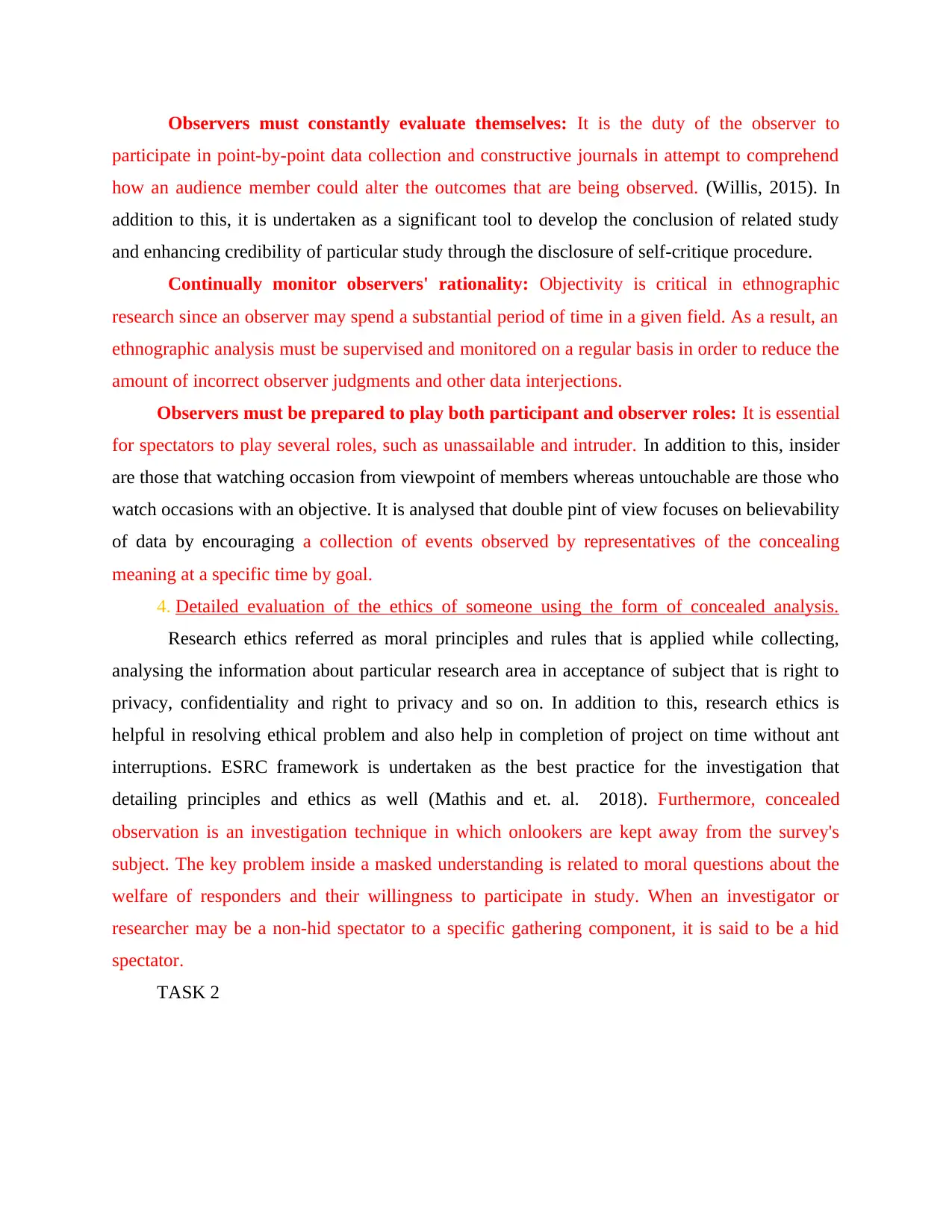
Observers must constantly evaluate themselves: It is the duty of the observer to
participate in point-by-point data collection and constructive journals in attempt to comprehend
how an audience member could alter the outcomes that are being observed. (Willis, 2015). In
addition to this, it is undertaken as a significant tool to develop the conclusion of related study
and enhancing credibility of particular study through the disclosure of self-critique procedure.
Continually monitor observers' rationality: Objectivity is critical in ethnographic
research since an observer may spend a substantial period of time in a given field. As a result, an
ethnographic analysis must be supervised and monitored on a regular basis in order to reduce the
amount of incorrect observer judgments and other data interjections.
Observers must be prepared to play both participant and observer roles: It is essential
for spectators to play several roles, such as unassailable and intruder. In addition to this, insider
are those that watching occasion from viewpoint of members whereas untouchable are those who
watch occasions with an objective. It is analysed that double pint of view focuses on believability
of data by encouraging a collection of events observed by representatives of the concealing
meaning at a specific time by goal.
4. Detailed evaluation of the ethics of someone using the form of concealed analysis.
Research ethics referred as moral principles and rules that is applied while collecting,
analysing the information about particular research area in acceptance of subject that is right to
privacy, confidentiality and right to privacy and so on. In addition to this, research ethics is
helpful in resolving ethical problem and also help in completion of project on time without ant
interruptions. ESRC framework is undertaken as the best practice for the investigation that
detailing principles and ethics as well (Mathis and et. al. 2018). Furthermore, concealed
observation is an investigation technique in which onlookers are kept away from the survey's
subject. The key problem inside a masked understanding is related to moral questions about the
welfare of responders and their willingness to participate in study. When an investigator or
researcher may be a non-hid spectator to a specific gathering component, it is said to be a hid
spectator.
TASK 2
participate in point-by-point data collection and constructive journals in attempt to comprehend
how an audience member could alter the outcomes that are being observed. (Willis, 2015). In
addition to this, it is undertaken as a significant tool to develop the conclusion of related study
and enhancing credibility of particular study through the disclosure of self-critique procedure.
Continually monitor observers' rationality: Objectivity is critical in ethnographic
research since an observer may spend a substantial period of time in a given field. As a result, an
ethnographic analysis must be supervised and monitored on a regular basis in order to reduce the
amount of incorrect observer judgments and other data interjections.
Observers must be prepared to play both participant and observer roles: It is essential
for spectators to play several roles, such as unassailable and intruder. In addition to this, insider
are those that watching occasion from viewpoint of members whereas untouchable are those who
watch occasions with an objective. It is analysed that double pint of view focuses on believability
of data by encouraging a collection of events observed by representatives of the concealing
meaning at a specific time by goal.
4. Detailed evaluation of the ethics of someone using the form of concealed analysis.
Research ethics referred as moral principles and rules that is applied while collecting,
analysing the information about particular research area in acceptance of subject that is right to
privacy, confidentiality and right to privacy and so on. In addition to this, research ethics is
helpful in resolving ethical problem and also help in completion of project on time without ant
interruptions. ESRC framework is undertaken as the best practice for the investigation that
detailing principles and ethics as well (Mathis and et. al. 2018). Furthermore, concealed
observation is an investigation technique in which onlookers are kept away from the survey's
subject. The key problem inside a masked understanding is related to moral questions about the
welfare of responders and their willingness to participate in study. When an investigator or
researcher may be a non-hid spectator to a specific gathering component, it is said to be a hid
spectator.
TASK 2
Paraphrase This Document
Need a fresh take? Get an instant paraphrase of this document with our AI Paraphraser
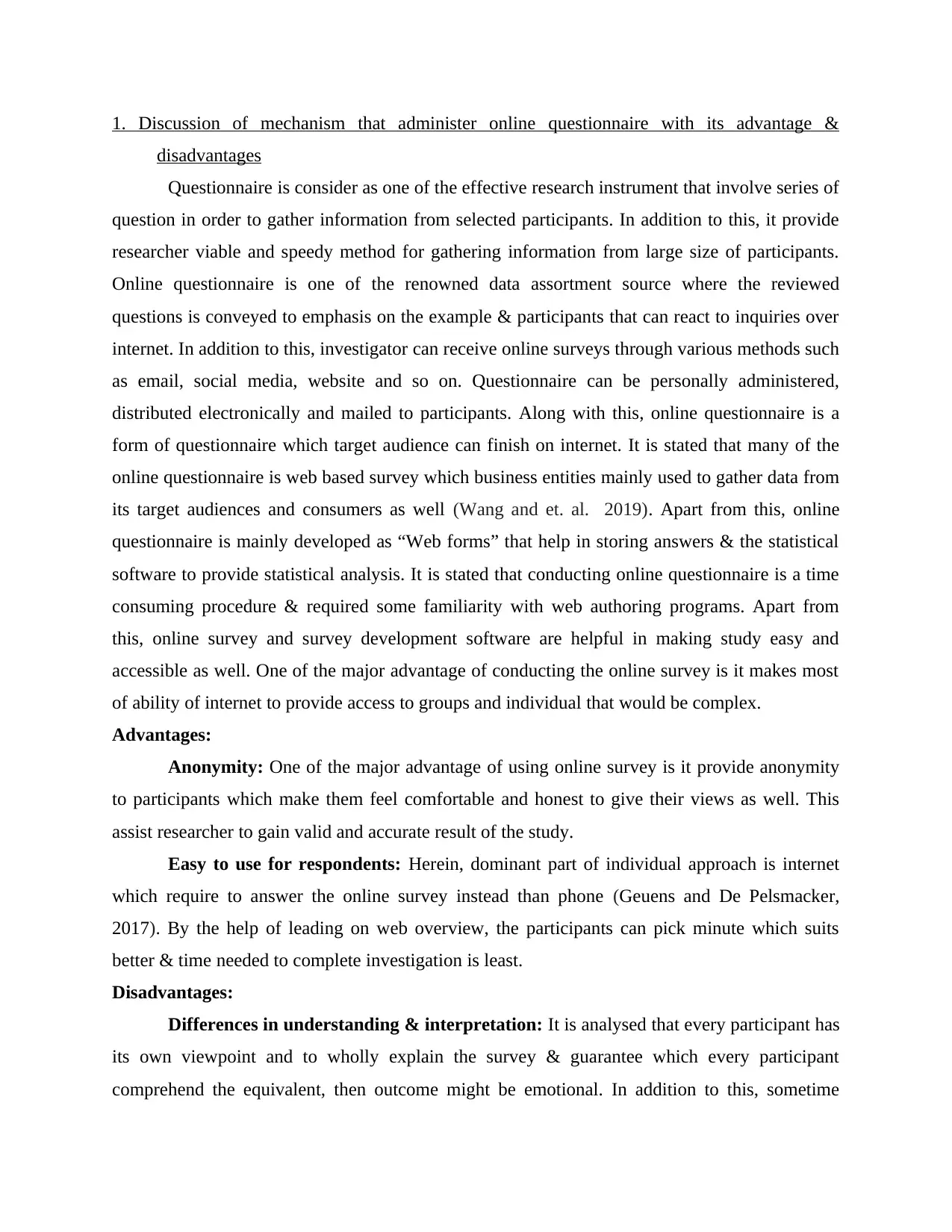
1. Discussion of mechanism that administer online questionnaire with its advantage &
disadvantages
Questionnaire is consider as one of the effective research instrument that involve series of
question in order to gather information from selected participants. In addition to this, it provide
researcher viable and speedy method for gathering information from large size of participants.
Online questionnaire is one of the renowned data assortment source where the reviewed
questions is conveyed to emphasis on the example & participants that can react to inquiries over
internet. In addition to this, investigator can receive online surveys through various methods such
as email, social media, website and so on. Questionnaire can be personally administered,
distributed electronically and mailed to participants. Along with this, online questionnaire is a
form of questionnaire which target audience can finish on internet. It is stated that many of the
online questionnaire is web based survey which business entities mainly used to gather data from
its target audiences and consumers as well (Wang and et. al. 2019). Apart from this, online
questionnaire is mainly developed as “Web forms” that help in storing answers & the statistical
software to provide statistical analysis. It is stated that conducting online questionnaire is a time
consuming procedure & required some familiarity with web authoring programs. Apart from
this, online survey and survey development software are helpful in making study easy and
accessible as well. One of the major advantage of conducting the online survey is it makes most
of ability of internet to provide access to groups and individual that would be complex.
Advantages:
Anonymity: One of the major advantage of using online survey is it provide anonymity
to participants which make them feel comfortable and honest to give their views as well. This
assist researcher to gain valid and accurate result of the study.
Easy to use for respondents: Herein, dominant part of individual approach is internet
which require to answer the online survey instead than phone (Geuens and De Pelsmacker,
2017). By the help of leading on web overview, the participants can pick minute which suits
better & time needed to complete investigation is least.
Disadvantages:
Differences in understanding & interpretation: It is analysed that every participant has
its own viewpoint and to wholly explain the survey & guarantee which every participant
comprehend the equivalent, then outcome might be emotional. In addition to this, sometime
disadvantages
Questionnaire is consider as one of the effective research instrument that involve series of
question in order to gather information from selected participants. In addition to this, it provide
researcher viable and speedy method for gathering information from large size of participants.
Online questionnaire is one of the renowned data assortment source where the reviewed
questions is conveyed to emphasis on the example & participants that can react to inquiries over
internet. In addition to this, investigator can receive online surveys through various methods such
as email, social media, website and so on. Questionnaire can be personally administered,
distributed electronically and mailed to participants. Along with this, online questionnaire is a
form of questionnaire which target audience can finish on internet. It is stated that many of the
online questionnaire is web based survey which business entities mainly used to gather data from
its target audiences and consumers as well (Wang and et. al. 2019). Apart from this, online
questionnaire is mainly developed as “Web forms” that help in storing answers & the statistical
software to provide statistical analysis. It is stated that conducting online questionnaire is a time
consuming procedure & required some familiarity with web authoring programs. Apart from
this, online survey and survey development software are helpful in making study easy and
accessible as well. One of the major advantage of conducting the online survey is it makes most
of ability of internet to provide access to groups and individual that would be complex.
Advantages:
Anonymity: One of the major advantage of using online survey is it provide anonymity
to participants which make them feel comfortable and honest to give their views as well. This
assist researcher to gain valid and accurate result of the study.
Easy to use for respondents: Herein, dominant part of individual approach is internet
which require to answer the online survey instead than phone (Geuens and De Pelsmacker,
2017). By the help of leading on web overview, the participants can pick minute which suits
better & time needed to complete investigation is least.
Disadvantages:
Differences in understanding & interpretation: It is analysed that every participant has
its own viewpoint and to wholly explain the survey & guarantee which every participant
comprehend the equivalent, then outcome might be emotional. In addition to this, sometime

participants face complexity in gaining insight about importance of few questions and to resolve
it, it is significant for researcher to develop say, quick questions to answer.
Limited sampling & participant availability: It is undertaken as one of the major
advantage of online questionnaire as population is less likely to have proper internet access &
respond to online questionnaire. Furthermore, depending on the website visits, creating the
analysis is difficult.
2. Principles of wording, stating and how these are significant in questionnaire design
Questionnaire design is consider as one of the vital area of research as it assist in
gathering reliable and valid information which in turn help in gaining positive results. It is stared
that wording is important in context of designing a questionnaire and therefore it is significant
for researcher to follow the principles of wording as it assist in designing questionnaire with
suitable and appropriate words (Yan and et. al. 2017). It also assist in develop the response rate
as require for gaining positive and reliable outcomes. The principles of wording is given below:
The questionnaire flow: It is important for researcher to avoid questioning sensitive
question in the starting of survey. It is suggested that if a relevant question is required, it should
be asked at the end of the questionnaire because by then, the participants have become
accustomed to giving answers and comprehending circumstances.
Keep it short and simple:It is one of the important consideration that is require while
designing questionnaire as make the question simple and short is easy to answer and also help in
getting better results.
Be natural in questioning: It is significant for investigator to ask natural and real
questions as many of the researcher finishing up by stating question which implicitly reconfirms
the pre-conceived opinions.
Don't assume respondents are expert:It is referred as the major mistake of investigator
as they assume participant are experts. It is analysed that participants are recognised to be
professionals when its all about industry experts (Yokoya, Grohnfeldt and Chanussot, 2017).
The researcher also require to ensure their participants feel motivated and give their responses as
well as opinions in a critical manner.
Ignore posing questions that go beyond the respondents' capacities, cognition, or
understanding: When asked to remember past events, researchers must please remember that
it, it is significant for researcher to develop say, quick questions to answer.
Limited sampling & participant availability: It is undertaken as one of the major
advantage of online questionnaire as population is less likely to have proper internet access &
respond to online questionnaire. Furthermore, depending on the website visits, creating the
analysis is difficult.
2. Principles of wording, stating and how these are significant in questionnaire design
Questionnaire design is consider as one of the vital area of research as it assist in
gathering reliable and valid information which in turn help in gaining positive results. It is stared
that wording is important in context of designing a questionnaire and therefore it is significant
for researcher to follow the principles of wording as it assist in designing questionnaire with
suitable and appropriate words (Yan and et. al. 2017). It also assist in develop the response rate
as require for gaining positive and reliable outcomes. The principles of wording is given below:
The questionnaire flow: It is important for researcher to avoid questioning sensitive
question in the starting of survey. It is suggested that if a relevant question is required, it should
be asked at the end of the questionnaire because by then, the participants have become
accustomed to giving answers and comprehending circumstances.
Keep it short and simple:It is one of the important consideration that is require while
designing questionnaire as make the question simple and short is easy to answer and also help in
getting better results.
Be natural in questioning: It is significant for investigator to ask natural and real
questions as many of the researcher finishing up by stating question which implicitly reconfirms
the pre-conceived opinions.
Don't assume respondents are expert:It is referred as the major mistake of investigator
as they assume participant are experts. It is analysed that participants are recognised to be
professionals when its all about industry experts (Yokoya, Grohnfeldt and Chanussot, 2017).
The researcher also require to ensure their participants feel motivated and give their responses as
well as opinions in a critical manner.
Ignore posing questions that go beyond the respondents' capacities, cognition, or
understanding: When asked to remember past events, researchers must please remember that
⊘ This is a preview!⊘
Do you want full access?
Subscribe today to unlock all pages.

Trusted by 1+ million students worldwide
1 out of 17
Related Documents
Your All-in-One AI-Powered Toolkit for Academic Success.
+13062052269
info@desklib.com
Available 24*7 on WhatsApp / Email
![[object Object]](/_next/static/media/star-bottom.7253800d.svg)
Unlock your academic potential
Copyright © 2020–2025 A2Z Services. All Rights Reserved. Developed and managed by ZUCOL.





